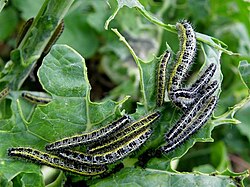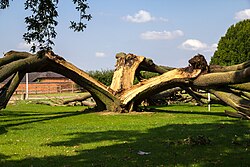Biology:Injury in plants
Injury in plants is damage caused by other organisms or by the non-living (abiotic) environment to plants. Animals that commonly cause injury to plants include insects, mites, nematodes, and herbivorous mammals; damage may also be caused by plant pathogens including fungi, bacteria, and viruses. Abiotic factors that can damage plants include heat, freezing, flooding, lightning, ozone gas, and pollutant chemicals.
Plants respond to injury by signalling that damage has occurred, by secreting materials to seal off the damaged area, by producing antimicrobial chemicals, and in woody plants by regrowing over wounds.
Factors
Biotic

Animals that commonly cause injury to plants include pests such as insects, mites, and nematodes. These variously bite or abrade plant parts such as leaves, stems, and roots, or as is common among the true bugs, pierce the plant's surface and suck plant juices. The resulting injuries may admit plant pathogens such as bacteria and fungi, which may extend the injury.[1] Caterpillar larvae of agricultural pests such as cabbage white butterflies (Pieridae) can completely defoliate Brassica crops.[2] Molluscs such as snails graze on plants including grasses and forbs, abrading them with their rasp-like radula; they can inflict substantial damage to crops.[3] Grazing mammals including livestock such as cattle, too, bite off or break parts of plants including grasses, forbs, and forest trees, causing injury, and again, potentially admitting pathogens.[4]
Abiotic

Abiotic factors that can damage plants include heat, freezing, flooding, lightning strikes, ozone gas, and pollutant chemicals.
Heat can kill any plant, given a sufficient temperature. Alpine plants tend to die at around 47 Celsius; temperate plants at around 51 Celsius; and tropical plants at nearly 58 Celsius: but there is some overlap depending on species. Similarly among cereal crops, temperate barley and oat die at around 49 Celsius, but tropical maize at 55 Celsius.[5]
Freezing affects plants variously, according to each species' ability to resist frost damage. Many forbs, including many garden flowers, are tender with little tolerance to frost, and die or are seriously damaged when frozen. Many woody plants are able to supercool, with tough buds and stems containing molecules that lower the freezing point or help to prevent the nucleation of ice crystals, and cell walls that mechanically protect cells against freezing.[6]
Flooding of soil quickly kills or injures many plants. The leaves become yellow (chlorosis) and die, progressively up the stem, within about five days after the roots are flooded. The roots lose the ability to absorb water and nutrients.[7]
Lightning strikes kill or injure plants, from root crops like beet and potato, which are instantly cooked in the ground, to trees such as coconut, through effects such as sudden heat and pressure shock waves created when water inside the plant flashes to steam. This can rupture stems and scorch any plant parts.[8]
Ozone, a gas, causes injury to leaves at concentrations from as little as 0.1 part per million in the atmosphere, such as may be found in or near large cities.[9] It is one of many pollutant chemicals that can damage plants.[10]
Plant responses

Plants respond to injury by signalling that damage has occurred,[11] by secreting materials to seal off the damaged area,[12] by producing antimicrobials to limit the spread of pathogens,[13] and in some woody plants by regrowing over the wound.[14]
Signalling
Plants produce chemicals at the injury site that signal the presence of damage and may help to reduce further damage. The chemicals involved depend to some extent on the plant species, though several of them are shared among species; and the signals given depend on the cause of the injury. Plants injured by spider mites release volatile chemicals that attract predatory mites, serving to reduce the attack on the plants. As another example, maize plants damaged by the caterpillars of noctuid moths release a mixture of terpenoid substances which attract the parasitoid wasp Cotesia marginiventris, which kills caterpillars.[11][15] Many plants give off such herbivory-induced signals.[16]
Wound occlusion
Plants secrete a variety of chemicals to help seal off damaged areas. For example, the grape vine Vitis vinifera is able to block the xylem water-transport tubes in its stems using the chemical tylose in summertime, and gels in wintertime when the plant is dormant. Tylose helps to prevent pathogens such as wood-rotting fungi and the bacterium Xylella fastidiosa from spreading through the plant: the chemical is produced as a response both to the bacterium and to mechanical damage such as viticultural pruning.[12]
Chemical defence
Many woody plants produce resins[17] and antimicrobial chemicals to limit the spread of pathogens after an injury.[13][18]
Wound healing
Many woody plants regrow around injuries, such as those caused by pruning. In time, such regrowth often completely covers the damaged area as the cambium growth layer produces new tissues. Well-pruned trees with undamaged branch collars often recover well, where poorly-pruned trees rot below the wound.[14][19][20]
See also
- Injury in invertebrates
- Injury in vertebrates
References
- ↑ Tarr, S. A. J. (1972). "Plant injury due to insects, mites, nematodes and other pests". Principles of Plant Pathology. London: Macmillan. pp. 126–137. doi:10.1007/978-1-349-00355-6_9. ISBN 978-1-349-00357-0.
- ↑ Theunissen, J.; Ouden, H.; Wit, A. K. H. (1985). "Feeding capacity of caterpillars on cabbage, a factor in crop loss assessment". Entomologia Experimentalis et Applicata (Wiley) 39 (3): 255–260. doi:10.1111/j.1570-7458.1985.tb00467.x. ISSN 0013-8703. Bibcode: 1985EEApp..39..255T.
- ↑ Silva, Oliveira; Teresa, Maria (1992). "Effects of mollusc grazing on the development of grassland species". Journal of Vegetation Science (Wiley) 3 (2): 267–270. doi:10.2307/3235689. ISSN 1100-9233. Bibcode: 1992JVegS...3..267S.
- ↑ Cappelli, Seraina Lisa; Koricheva, Julia (2 July 2021). "Interactions between mammalian grazers and plant pathogens: an elephant in the room?". New Phytologist (Wiley) 232 (1): 8–10. doi:10.1111/nph.17533. ISSN 0028-646X. PMID 34213785.
- ↑ Smillie, R.M.; Nott, R. (1979). "Heat Injury in Leaves of Alpine, Temperate and Tropical Plants". Functional Plant Biology (CSIRO Publishing) 6 (1): 135. doi:10.1071/pp9790135. ISSN 1445-4408.
- ↑ Burke, M. J.; Gusta, L. V.; Quamme, H. A.; Weiser, C. J.; Li, P. H. (1976). "Freezing and Injury in Plants". Annual Review of Plant Physiology (Annual Reviews) 27 (1): 507–528. doi:10.1146/annurev.pp.27.060176.002451. ISSN 0066-4294.
- ↑ Kramer, Paul J. (1 October 1951). "Causes of Injury to Plants Resulting from Flooding of the Soil". Plant Physiology (Oxford University Press) 26 (4): 722–736. doi:10.1104/pp.26.4.722. ISSN 0032-0889. PMID 16654407.
- ↑ Nelson, Scot C. (July 2008). "Lightning Injury to Plants". Plant Disease (PD-40). https://www.ctahr.hawaii.edu/oc/freepubs/pdf/PD-40.pdf.
- ↑ Hill, A. C.; Pack, M. R.; Treshow, M. (1961). "Plant injury induced by ozone". Phytopathology 51. https://www.osti.gov/biblio/5518148.
- ↑ Heath, R. L. (1980). "Initial Events in Injury to Plants by Air Pollutants". Annual Review of Plant Physiology (Annual Reviews) 31 (1): 395–431. doi:10.1146/annurev.pp.31.060180.002143. ISSN 0066-4294.
- ↑ 11.0 11.1 Turlings, Ted C.; Tumlinson, James H. (1992). "Systemic release of chemical signals by herbivore-injured corn". Proceedings of the National Academy of Sciences 89 (17): 8399–8402. doi:10.1073/pnas.89.17.8399. PMID 11607325. Bibcode: 1992PNAS...89.8399T.
- ↑ 12.0 12.1 Sun, Qiang; Rost, Thomas L.; Matthews, Mark A. (2008). "Wound-induced vascular occlusions in Vitis vinifera (Vitaceae): Tyloses in summer and gels in winter1". American Journal of Botany (Wiley) 95 (12): 1498–1505. doi:10.3732/ajb.0800061. ISSN 0002-9122. PMID 21628157.
- ↑ 13.0 13.1 Shigo, Alex L. (1985). "Compartmentalization of Decay in Trees". Scientific American 252 (4): 96–103. doi:10.1038/scientificamerican0485-96. ISSN 0036-8733. Bibcode: 1985SciAm.252d..96S. http://ageconsearch.umn.edu/record/309547.
- ↑ 14.0 14.1 Shigo, Alex L. (1985). "How tree branches are attached to trunks". Canadian Journal of Botany 63 (8): 1391–1401. doi:10.1139/b85-193.
- ↑ Harris, Christina M.; Ruberson, John R.; Meagher, Robert; Tumlinson, James H. (1 April 2012). "Host Suitability Affects Odor Association in Cotesia marginiventris: Implications in Generalist Parasitoid Host-Finding" (in en). Journal of Chemical Ecology 38 (4): 340–347. doi:10.1007/s10886-012-0095-9. ISSN 1573-1561. PMID 22438015. https://link.springer.com/article/10.1007/s10886-012-0095-9. Retrieved 15 July 2022.
- ↑ Wu, J.; Baldwin, I.T. (2009). "Herbivory-induced signalling in plants: Perception and action". Plant Cell Environment 32 (9): 1161–1174. doi:10.1111/j.1365-3040.2009.01943.x. PMID 19183291.
- ↑ "Resins". http://www.fs.fed.us/wildflowers/ethnobotany/resins.shtml.
- ↑ González-Lamothe, Rocío; Mitchell, Gabriel; Gattuso, Mariza; Diarra, Moussa; Malouin, François; Bouarab, Kamal (31 July 2009). "Plant Antimicrobial Agents and Their Effects on Plant and Human Pathogens". International Journal of Molecular Sciences (MDPI AG) 10 (8): 3400–3419. doi:10.3390/ijms10083400. ISSN 1422-0067. PMID 20111686.
- ↑ O'Hara, Kevin L. (2007). "Pruning Wounds and Occlusion: A Long-Standing Conundrum in Forestry". Journal of Forestry 105 (3): 131–138. doi:10.1093/jof/105.3.131. https://academic.oup.com/jof/article/105/3/131/4598767.
- ↑ "Tree pruning guide". US Forest Service for the US Department of Agriculture. Archived from the original on April 26, 2007. https://web.archive.org/web/20070426071433/http://www.na.fs.fed.us/spfo/pubs/howtos/ht_prune/cuts.htm. Features a diagram of the branch collar.
 |


